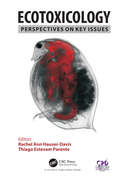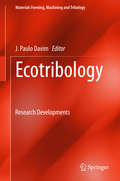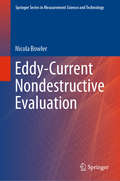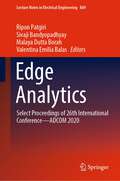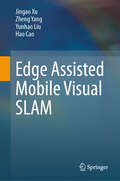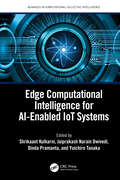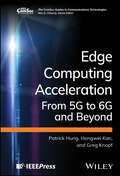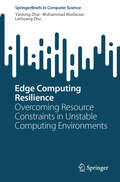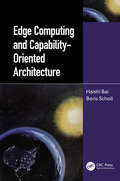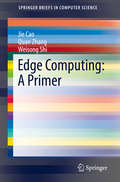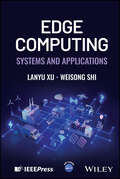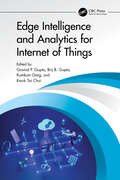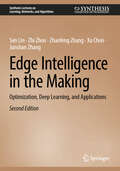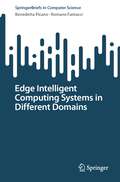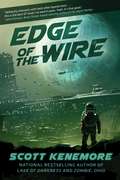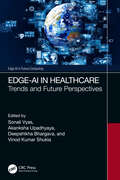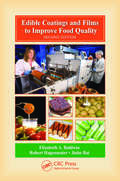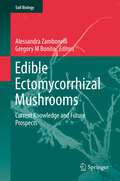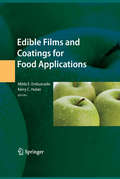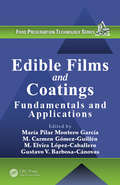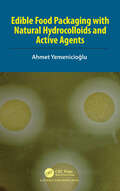- Table View
- List View
Ecotoxicology: Effects of Pollutants on the Natural Environment
by Colin WalkerChemical Warfare in NaturePesticides and other industrial chemicals are at the root of many pollution problems. In view of the toxic effects of industrial chemicals found in the water, soil, and air, Ecotoxicology: Effects of Pollutants on the Natural Environment considers the impact of chemicals on the environment from a wider perspective: the evo
Ecotoxicology: Perspectives on Key Issues
by Rachel Ann Hauser-Davis Thiago Estevam ParenteThis book presents an integrated discussion on ecotoxicology, containing both general concepts and specific ecotoxicological issues of major biological groups, extending beyond conventional systems. It explores worldwide, regional, and biocompartmentalized topics, bringing forth new points of view on global issues and addressing the increasing diversity and complexity of the ecotoxicological field. It also contains novel information on emerging contaminants, presents bioaccumulation effects on different levels of ecological organization and risk analyses, and discusses novel fields of methodological applications, including key aspects in ecotoxicological and environmental monitoring studies.
Ecotribology
by J. Paulo DavimThis book presents resent research advances in the area of eco-triobology. In the last years, eco-tribology or environmentally friendly tribology has gained increasing importance in sustainable engineering. Environmentally acceptable tribological practices save resources by optimizing product usage and reducing energy. This book covers current developments in all areas covered by the term eco-tribology, including biomimetics surfaces, control of friction and wear, environmental aspects of lubrication and surface modification techniques as well as tribological aspects of green applications, such wind-power turbines or solar panels.
Eddy-Current Nondestructive Evaluation (Springer Series in Measurement Science and Technology)
by Nicola BowlerThis book covers the topic of eddy current nondestructive evaluation, the most commonly practiced method of electromagnetic nondestructive evaluation (NDE). It emphasizes a clear presentation of the concepts, laws and relationships of electricity and magnetism upon which eddy current inspection methods are founded. The chapters include material on signals obtained using many common eddy current probe types in various testing environments. Introductory mathematical and physical concepts in electromagnetism are introduced in sufficient detail and summarized in the Appendices for easy reference. Worked examples and simple calculations that can be done by hand are distributed throughout the text. These and more complex end-of-chapter examples and assignments are designed to impart a working knowledge of the connection between electromagnetic theory and the practical measurements described. The book is intended to equip readers with sufficient knowledge to optimize routine eddy current NDE inspections, or design new ones. It is useful for graduate engineers and scientists seeking a deeper understanding of electromagnetic methods of NDE than can be found in a guide for practitioners.
Edge Analytics: Select Proceedings of 26th International Conference—ADCOM 2020 (Lecture Notes in Electrical Engineering #869)
by Valentina Emilia Balas Sivaji Bandyopadhyay Ripon Patgiri Malaya Dutta BorahThis book constitutes refereed proceedings of the 26th annual International Conference on Advanced Computing and Communications (ADCOM 2020). ADCOM, the flagship Systems Conference of the ACCS, is a major annual international meeting that draws leading scientists and researchers in computational and communications engineering from across industry and academia. The proceedings highlight the growing importance of large-scale systems engineering and discuss leading-edge research and trends. The main theme of ADCOM 2020 is Edge Analytics. The book includes novel contributions and latest developments from researchers across industry and academia who are working in security, privacy, and data analytics from both technological and social perspectives. The book serves as a valuable reference resource for academics and researchers across the globe.
Edge Assisted Mobile Visual SLAM
by Yunhao Liu Zheng Yang Jingao Xu Hao CaoIn an age where real-time processing and interaction with the physical world through digital lenses are paramount, visual SLAM technology has become the backbone of mobile AR/VR applications, robotics, and autonomous systems. However, the demanding computational load of visual SLAM often strains the limited resources of mobile devices, hindering performance and accuracy. This is exactly where edge computing comes to the forefront, offering a potent solution by performing data processing at the edge of the network, closer to the source of data. This monograph is a pioneering exploration into how edge computing can elevate visual SLAM systems, overcoming the traditional challenges of computational intensity and resource constraints. Edge computing not only offloads heavy-duty processing from mobile devices to edge servers but also mitigates latency, enhances efficiency, and ensures robust, real-time performance. This monograph unveils the transformative potential of edge-assisted visual SLAM, presenting groundbreaking research and the latest advancements in task decoupling, collaborative mapping, and environmental interaction. This monograph could serve as a scholarly resource for those within the fields of computer vision and mobile computing. It presents a detailed exploration of current research in edge-assisted visual SLAM and anticipates future developments, offering readers a comprehensive understanding of the field's trajectory and its implications for the next generation of mobile applications and autonomous systems.
Edge Computational Intelligence for AI-Enabled IoT Systems (Advances in Computational Collective Intelligence)
by Shrikaant Kulkarni Dinda Pramanta Yuichiro Tanaka Jaiprakash Narain DwivediEdge computational intelligence is an interface between edge computing and artificial intelligence (AI) technologies. This interfacing represents a paradigm shift in the world of work by enabling a broad application areas and customer-friendly solutions. Edge computational intelligence technologies are just in their infancy. Edge Computational Intelligence for AI-Enabled IoT Systems looks at the trends and advances in edge computing and edge AI, the services rendered by them, related security and privacy issues, training algorithms, architectures, and sustainable AI-enabled IoT systems.Together, these technologies benefit from ultra-low latency, faster response times, lower bandwidth costs and resilience from network failure, and the book explains the advantages of systems and applications using intelligent IoT devices that are at the edge of a network and close to users. It explains how to make most of edge and cloud computing as complementary technologies or used in isolation for extensive and widespread applications. The advancement in IoT devices, networking facilities, parallel computation and 5G, and robust infrastructure for generalized machine learning have made it possible to employ edge computational intelligence in diverse areas and in diverse ways.The book begins with chapters that cover Edge AI services on offer as compared to conventional systems. These are followed by chapters that discuss security and privacy issues encountered during the implementation and execution of edge AI and computing services The book concludes with chapters looking at applications spread across different areas of edge AI and edge computing and also at the role of computational intelligence in AI-driven IoT systems.
Edge Computing Acceleration: From 5G to 6G and Beyond (The ComSoc Guides to Communications Technologies)
by Patrick Hung Hongwei Kan Greg KnopfDiscover the latest advances in computer architecture and software at the dawn of the 5G/6G era In Edge Computing Acceleration: From 5G to 6G and Beyond, distinguished researchers Dr. Patrick Hung, Hongwei Kan, and Greg Knopf deliver a comprehensive overview of personal computer architecture and software design usage in the upcoming 5G decade. The authors begin by introducing key components and exploring different hardware acceleration architectures. They move on to discuss 5G data security and data integrity and offer a survey of network virtualization technologies, including accelerated virtualization technologies. The book analyzes 5G/6G system performance, investigating key design considerations and trade-offs and introducing high-level synthesis flow. It concludes with chapters exploring design verification and validation flow, illustrations of 5G applications based on artificial intelligence and other emerging technologies and offering highlights of emerging 6G research and roadmaps. Readers will enjoy the combination of accessible descriptions of new technologies presented side-by-side as a step-by-step guide to designing effective 5G systems. The book also includes: A thorough introduction to key 5G/6G components, including new wireless communication protocols, edge and fog computing, acceleration technologies, IoE architectures, software-designed networks, network function virtualization, and data securityExplorations of various hardware acceleration architectures, like FPGA and GPU acceleration architecturesPractical discussions of 5G/6G data security, data integrity, and a survey of network virtualization technologiesIn-depth treatments of 5G/6G system performance, key design considerations, high-level synthesis flow, design verification, and validation flow Perfect for undergraduate and graduate students in programs related to communications technology, engineering, and computer science, Edge Computing Acceleration: From 5G to 6G and Beyond is a must-have resource for engineers, programmers, system architects, technical managers, communications business executives, telco operators, and government regulators who regularly interact with cutting-edge communications equipment.
Edge Computing Resilience: Overcoming Resource Constraints in Unstable Computing Environments (SpringerBriefs in Computer Science)
by Liehuang Zhu Yanlong Zhai Muhammad MudassarEdge computing has emerged as a powerful technology for efficiently executing tasks by pushing cloud computing capabilities to the edge of the network. This approach significantly improves the quality of services of IoT applications and greatly enhances the performance of resource-constraint edge devices. However, with the explosive growth in users and data generation, low-computing-capability devices often struggle to meet computation demands in time, posing a significant challenge to the success of edge computing. These challenges include latency requirements, low computational power, system heterogeneity, energy constraints and privacy issues. To address these challenges, it is critical to design robust edge computing systems. This book provides a systematic and comprehensive analysis of edge computing challenges and presents resilient designs and frameworks suitable for real-time edge computing applications. The discussion primarily focuses on overcoming resource constraints in unstable edge computing environments, which is achieved through various concepts and technologies, such as fault handling, optimization and computation offloading. The book is significant to researchers in the field of edge computing, especially in the context of the resource-constrained paradigm, IoT application execution in the edge and fog computing. The book features innovative models and frameworks for processing time-critical, energy-aware and privacy-aware applications. By reading this book, researchers and professionals will gain a deeper understanding of different technologies and frameworks for edge computing and develop an appreciation for edge computing resilience. This resilience makes the edge system robust against frequent system failures for real-time IoT applications. The book provides a foundation for future research in this field and is an essential read for those seeking to advance their knowledge and expertise in edge computing.
Edge Computing and Capability-Oriented Architecture
by Haishi Bai Boris SchollFueled by ubiquitous computing ambitions, the edge is at the center of confluence of many emergent technological trends such as hardware-rooted trust and code integrity, 5G, data privacy and sovereignty, blockchains and distributed ledgers, ubiquitous sensors and drones, autonomous systems and real-time stream processing. Hardware and software pattern maturity have reached a tipping point so that scenarios like smart homes, smart factories, smart buildings, smart cities, smart grids, smart cars, smart highways are in reach of becoming a reality. While there is a great desire to bring born-in-the-cloud patterns and technologies such as zero-downtime software and hardware updates/upgrades to the edge, developers and operators alike face a unique set of challenges due to environmental differences such as resource constraints, network availability and heterogeneity of the environment. The first part of the book discusses various edge computing patterns which the authors have observed, and the reasons why these observations have led them to believe that there is a need for a new architectural paradigm for the new problem domain. Edge computing is examined from the app designer and architect’s perspectives. When they design for edge computing, they need a new design language that can help them to express how capabilities are discovered, delivered and consumed, and how to leverage these capabilities regardless of location and network connectivity. Capability-Oriented Architecture is designed to provide a framework for all of these. This book is for everyone who is interested in understanding what ubiquitous and edge computing means, why it is growing in importance and its opportunities to you as a technologist or decision maker. The book covers the broad spectrum of edge environments, their challenges and how you can address them as a developer or an operator. The book concludes with an introduction to a new architectural paradigm called capability-based architecture, which takes into consideration the capabilities provided by an edge environment. .
Edge Computing: A Primer (SpringerBriefs in Computer Science)
by Jie Cao Quan Zhang Weisong ShiThe success of the Internet of Things and rich cloud services have helped create the need for edge computing, in which data processing occurs in part at the network edge, rather than completely in the cloud. In Edge Computing: A Primer the vision and definition of Edge computing is introduced, as well as several key techniques that enable Edge computing. Then, four applications that benefit from Edge computing are presented as case studies, ranging from smart homes and public safety to medical services, followed by a discussion of several open challenges and opportunities in Edge computing. Finally, several key tools for edge computing such as virtualization and resource management are explained.
Edge Computing: From Hype to Reality (EAI/Springer Innovations in Communication and Computing)
by Fadi Al-TurjmanIn this book, contributors provide insights into the latest developments of Edge Computing/Mobile Edge Computing, specifically in terms of communication protocols and related applications and architectures. The book provides help to Edge service providers, Edge service consumers, and Edge service developers interested in getting the latest knowledge in the area. The book includes relevant Edge Computing topics such as applications; architecture; services; inter-operability; data analytics; deployment and service; resource management; simulation and modeling; and security and privacy. Targeted readers include those from varying disciplines who are interested in designing and deploying Edge Computing.Features the latest research related to Edge Computing, from a variety of perspectives;Tackles Edge Computing in academia and industry, featuring a variety of new and innovative operational ideas;Provides a strong foundation for researchers to advance further in the Edge Computing domain.
Edge Computing: Systems and Applications
by Weisong Shi Lanyu XuUnderstand the computing technology that will power a connected future The explosive growth of the Internet of Things (IoT) in recent years has revolutionized virtually every area of technology. It has also driven a drastically increased demand for computing power, as traditional cloud computing proved insufficient in terms of bandwidth, latency, and privacy. Edge computing, in which data is processed at the edge of the network, closer to where it’s generated, has emerged as an alternative which meets the new data needs of an increasingly connected world. Edge Computing offers a thorough but accessible overview of this cutting-edge technology. Beginning with the fundamentals of edge computing, including its history, key characteristics, and use cases, it describes the architecture and infrastructure of edge computing and the hardware that enables it. The book also explores edge intelligence, where artificial intelligence is integrated into edge computing to enable smaller, faster, and more autonomous decision-making. The result is an essential tool for any researcher looking to understand this increasingly ubiquitous method for processing data. Edge Computing readers will also find: Real-world applications and case studies drawn from industries including healthcare and urban developmentDetailed discussion of topics including latency, security, privacy, and scalabilityA concluding summary of key findings and a look forward at an evolving computing landscape Edge Computing is ideal for students, professionals, and enthusiasts looking to understand one of technology’s most exciting new paradigms.
Edge Intelligence and Analytics for Internet of Things
by Brij B. Gupta Govind P. Gupta Kwok Tai Chui Kumkum GargEdge computing and intelligence is a new technical discipline that researches and develops theories, methods, technologies, and application systems for enabling fast and efficient processing and intelligent decision-making using the big data generated from the Internet of Things (IoT) system. The edge computing and intelligence–enabled IoT system helps in alleviating the resource limitations of IoT devices and facilitates large-scale deployment of IoT systems for different applications such as smart cities, smart grids, smart homes, smart healthcare systems, smart video surveillance, and e-healthcare.Due to the deployment of the IoT devices in the open environment and their interaction with other IoT devices through unstable and unreliable wireless channels, as well as the placement of edge nodes near IoT systems, IoT devices offer many chances for malicious attackers to compromise them through collusion attacks, denial-of-service attacks, and many other types of attacks. Analysis of the network traffic and IoT data at the edge nodes using the latest artificial intelligence techniques will address a number of issues, such as anomaly detection in IoT data, data poisoning attacks, and other security and privacy issues related to IoT systems. In this book, we will provide an overview of the fundamental concepts of edge computing, edge intelligence using advanced machine- and deep-learning models, the architecture of edge computing–based IoT systems, and edge computing–based cyber threat intelligence solutions for IoT systems.
Edge Intelligence in the Making: Optimization, Deep Learning, and Applications (Synthesis Lectures on Learning, Networks, and Algorithms)
by Xu Chen Junshan Zhang Sen Lin Zhi Zhou Zhaofeng ZhangThis book conducts a comprehensive and detailed survey of the recent research efforts in edge intelligence. The authors first review the background and present motivation for AI running at the network edge. The book then provides an overview of the overarching architectures, frameworks, and emerging key technologies for deep learning models toward training/inference at the network edge. To illustrate the research problems for edge intelligence, the book also showcases four of the authors' own research projects on edge intelligence, ranging from rigorous theoretical analysis to studies based on realistic implementation. This second edition incorporates the latest research in this rapidly developing area. The authors also highlight the current applications and future research opportunities for edge intelligence.
Edge Intelligent Computing Systems in Different Domains (SpringerBriefs in Computer Science)
by Romano Fantacci Benedetta PicanoThis book provides a comprehensive and systematic exploration of next-generation Edge Intelligence (EI) Networks. It delves deep into the critical design considerations within this context, emphasizing the necessity for functional and dependable interactions between networking strategies and the diverse application scenarios. This should help assist to encompass a wide range of environments.This book also discusses topics such as resource optimization, incentive mechanisms, channel prediction and cutting-edge technologies, which includes digital twins and advanced machine learning techniques. It underscores the importance of functional integration to facilitate meaningful collaborations between networks and systems, while operating across heterogeneous environments aiming support novel and disruptive human-oriented services and applications. Valuable insights into the stringent requirements for intelligence capabilities, communication latency and real-time response are discussed. This characterizes the new EI era, driving the creation of comprehensive cross-domain architectural ecosystems that infuse human-like intelligence into every aspect of emerging EI systems.This book primarily targets advanced-level students as well as postdoctoral researchers, who are new to this field and are searching for a comprehensive understanding of emerging EI systems. Practitioners seeking guidance in the development and implementation of EI systems in practical contexts will also benefit from this book.
Edge of the Wire
by Scott KenemoreA Mind-Bending Science Fiction Thriller That Lays Bare Our Coming Dependence on AI An elite crew of astronauts is sent to an unknown planet. Their mission? To wire the planet within the all-encompassing and all-knowing system of artificial intelligence, known as "The Goo." It&’s hard to remember a time before The Goo . . . and even harder to imagine a future without it. The advanced AI system anticipates humanity's wants, needs, and desires, and seems to have an unfailing omniscience. But when Rowe, the leader of the crew, discovers mysterious secrets buried beneath the surface of this unknown planet, his faith in AI begins to wane. One unsettling twist after another turns Rowe&’s mission into a quest for answers and a terrifying fight for survival. Scott Kenemore&’s inimitable style incorporates elements of horror and satire, making Edge of the Wire a chilling triumph of the science fiction genre and also a rollicking send-up of today's tech culture. With ripped-from-the-headlines concerns about a "wired future" brought bracingly to life, this novel delivers an entertaining yet harrowing look at the existential crisis of the moment—humanity's increasing dependence on artificial intelligence.
Edge-AI in Healthcare: Trends and Future Perspectives (Edge AI in Future Computing)
by Sonali Vyas, Akanksha Upadhyaya, Deepshikha Bhargava, and Vinod Kumar ShuklaThe book provides comprehensive research ideas about Edge-AI technology that can assist doctors in making better data-driven decisions. It provides insights for improving the healthcare industry by examining future trends, simplifying decision making and investigating structured and unstructured data.Edge-AI in Healthcare: Trends and Future Perspective is more than a comprehensive introduction to Artificial Intelligence as a tool in healthcare data. The book is split into five chapters covering the entire healthcare ecosystem. First section is introduction to Edge-AI in healthcare. It discusses data usage, modelling and simulation techniques as well as machine and deep learning approaches. The second section discusses the implementation of edge AI for smart healthcare. The topics discussed in this section include, AR/VR and cloud computing, big data management, algorithms, optimization, and IoMT techniques and methods. Third section covers role of Edge-AI in healthcare and the challenges and opportunities of the technologies. This section also provides case studies and discusses sustainability, security, privacy, and trust related to Edge-AI in healthcare. This book is intended to benefit researchers, academics, industry professionals, R & D organizations and students working in the field of healthcare, healthcare informatics and their applications.
Edible Alliums: Botany, Production and Uses (Botany, Production and Uses)
by Brian Thomas Haim D. RabinowitchAllium crops include more than 30 species, many of which (for e.g. onions, shallots, garlic, leeks, bunching onions, and chives) are of economic importance. Bulb onions rank second only to tomatoes in terms of global production. Alliums are farmed and harvested in a range of climatic conditions worldwide, forming important parts of local diets. This book provides a comprehensive review of major and minor Allium crops from scientific and horticultural perspectives. It broadly covers modern biology (including genetics and breeding), propagation, production, processing, and nutritional and health benefits. Edible Alliums contains coverage of: Both major and minor Allium crops. Improving crop production, quality, and sustainability of Allium crops. Advances in digital technologies, 'omics' research and gene editing. Objectives for improving crop performance, such as integrated crop management, the plant-soil interface, improving propagation materials, post-harvest quality and reducing waste. This is an essential resource for scholars, researchers and students in plant science and agriculture, in addition to molecular biologists, plant breeders, agronomists, consultants, and extension specialists.
Edible Coatings and Films to Improve Food Quality
by Elizabeth A. Baldwin Robert Hagenmaier Jinhe BaiSince the publication of the first edition of this text, ever-increasing coatings research has led to many developments in the field. Updated and completely revised with the latest discoveries, Edible Coatings and Films to Improve Food Quality, Second Edition is a critical resource for all those involved in buying, selling, regulating, developing,
Edible Ectomycorrhizal Mushrooms
by Alessandra Zambonelli Gregory M BonitoEdible ectomycorrhizal mushrooms (EEMMs) comprise more than 1000 species and are an important food and forest resource. In this volume of Soil Biology, internationally recognized scientists offer their most recent research findings on these beguiling fungi. Topics covered include: complex ecological interactions between plants, EEMMs, and soil organisms; comparative genomics, high-throughput sequencing and modern research tools; genetic selection of fungal strains and techniques for inoculating plants; economic and social considerations surrounding wild collected EEMMs; and practical information concerning soil management and EEMM cultivation. The book will be a useful guide for anyone interested in soil ecology, forestry, or the genetics and cultivation of EEMMs, and provides an extensive knowledge base and inspirations for future studies on these ecologically and economically important fungi.
Edible Film and Coatings: Innovative Applications for Packaging and Food Preservation
by Jian Ju Fangyuan ZhaoEdible films and coatings can be environmentally friendly alternative materials serving as both food preservative and food packaging. This book describes the effects of foodborne microorganisms and food oxidation on food storage quality and current food preservation strategies. Basic information and practical applications of various edible films and coatings for potential use in food packaging are provided, preparation methods of different types of edible films and coatings are described, and industrial applicability of these technologies is emphasized. The book describes the use of edible films or coatings to prevent corruption and oxidation of fruits or fresh-cut fruits and meat products.Key Features: Describes the preparation methods and required materials for different types of edible films and coatings, emphasizing industrial applicability Explains the theory of slow controlled release of active ingredients in packaging materials and the migration of packaging elements into food Discusses the key technologies for the preparation of edible antimicrobial packaging materials and functional edible coatings
Edible Films and Coatings for Food Applications
by Milda E. Embuscado Kerry C. HuberEdible films and coatings play an important role in the quality, safety, transportation, storage, and display of a wide range of fresh and processed foods. Edible films and coatings, while preventing moisture loss and maintaining quality, prevent spoilage and microbial contamination of foods. The edible film and coating industry is now a multimillion dollar industry. Less than $1 million in 1999, the market has grown to more than $100 million and is expected to grow to $350 million by 2008, according to James Rossman of Rossman Consulting. Pharmaceutical and consumer products have been responsible for the tremendous increase. This growth has produced an enormous amount of scientific articles, patents, and research projects undertaken by members of the food industry, academia, and research institutions. Edible Films and Coatings for Food Applications brings together this vast wealth of scientific knowledge in a systematically organized volume. It examines the science, application, function, and market for edible films and coatings.
Edible Films and Coatings: Fundamentals and Applications (Food Preservation Technology)
by María Pilar Montero García, M. Carmen Gómez-Guillén, M. Elvira López-Caballero and Gustavo V. Barbosa-CánovasThe search for better strategies to preserve foods with minimal changes during processing has been of great interest in recent decades. Traditionally, edible films and coatings have been used as a partial barrier to moisture, oxygen, and carbon dioxide through selective permeability to gases, as well as improving mechanical handling properties. The advances in this area have been breathtaking, and in fact their implementation in the industry is already a reality. Even so, there are still new developments in various fields and from various perspectives worth reporting. Edible Films and Coatings: Fundamentals and Applications discusses the newest generation of edible films and coatings that are being especially designed to allow the incorporation and/or controlled release of specific additives by means of nanoencapsulation, layer-by-layer assembly, and other promising technologies. Covering the latest novelties in research conducted in the field of edible packaging, it considers state-of-the-art innovations in coatings and films; novel applications, particularly in the design of gourmet foods; new advances in the incorporation of bioactive compounds; and potential applications in agronomy, an as yet little explored area, which could provide considerable advances in the preservation and quality of foods in the field.
Edible Food Packaging with Natural Hydrocolloids and Active Agents
by Ahmet YemenicioğluThe aim of this book is to show the potential of natural hydrocolloids and active agents to develop sustainable edible packaging materials for food preservation. For this, the current and future sources of natural hydrocolloids have been reviewed along with their extraction methods, impact on health and ability to form different packaging such as film, casing, coating, mat, pad, etc. Similarly, natural active compounds were evaluated carefully considering their sources, extraction methods, regulatory status, and compatibility with edible packaging. The book emphasizes the recent developments in methods, strategies and technologies employed to enhance the performance of antimicrobial, antioxidant and bioactive packaging. The basic testing methods used to evaluate antimicrobial and antioxidant activity of edible packaging in model media and food were discussed, and carefully selected example active edible packaging applications for different food categories were provided with critical details such as the thin balance between effectiveness of packaging and sensory properties of food. As such, it helps in understanding necessary parameters in designing an effective active edible packaging that is applicable to the target food category. Moreover, readers are primed for the first time on how to develop a fully natural antimicrobial, antioxidant or bioactive edible food packaging. This book is different from most of the similar books' avail as it provides neither methodologies about classical active packaging based on chemicals and fossil polymeric films nor is it a thorough collection of different food packaging applications. It is also not a book that concentrates on physicochemical characterization methods and engineering aspects of packaging. Instead, this is a book that provides systematic knowledge about key methods of evaluating natural resources, agro-industrial wastes and by-products for development of edible packaging, and concentrates on concepts, strategies, technologies, and applications of active edible packaging based solely on natural components. It is designed to share both positive and negative experiences in an emerging field that is expected to play a central role in improving food safety and quality, human health and environmentally friendly practices.

